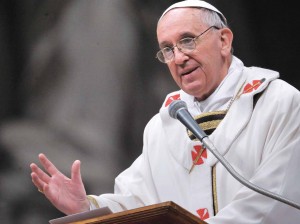 Did the bishops gathered for the October Synod on the family “quarrel”?
Did the bishops gathered for the October Synod on the family “quarrel”?
Pope Francis pondered that question during his General Audience in St. Peter’s Square on Wednesday, December 10, 2011. “Well, I don’t know if they quarreled,” Francis said. “But they spoke strongly,” he added, prompting the laughter of the audience.
Anyone who followed those proceedings at all could be forgiven for thinking the Holy Father’s words an understatement. Francis was quick to point out that the Apostles themselves “quarreled” when they gathered to resolve disagreements in the early Church.
Chapter 15 of Acts of the Apostles recounts the controversy that arose circa 48 A.D. in Antioch over whether Gentile converts to Christianity needed to follow the Law of Moses, including the rule of male circumcision. St. Paul, Barnabas and Titus were sent to consult the Apostles and Elders of Jerusalem, including SS. Peter and James.
The issue had aroused “no small dissension and disputation” at the Church in Antioch (Acts 15:2) and produced “much disputing” at the Council which was quelled by the intervention of St. Peter (Acts 15:7).
If that reminds anyone of what happened at October’s Synod, it would come as no surprise to Pope Francis. “A strong argument broke out,” says Francis, “because they were seeking the will of God in regard to pagans.” He adds, “When the will of God is sought in a Synod Assembly, there are always different points of view and there is argument and this is not a bad thing! – so long as it is done with humility and with a spirit of service to the assembly of brothers.”
Synods were widely used in the early Church, and they included meetings to decide universal questions such as the Council of Jerusalem in Acts 15, as well as regional meetings like the Synod of Hippo (393 A.D.), attended by St. Augustine, which authorized the contents of the Bible for the Church in Northern Africa, subject to Rome’s approval.
Synods have been used continually in the Orthodox Churches but, until recently, had been discontinued in the West. Pope Bl. Paul VI reestablished their use through his motu proprio “Apostolica Sollicitudo” (1965), which is now codified in Church Law. Pope Paul brought back the Synod, “with the aim of providing for a continuance after the Council of the great abundance of benefits that We have been so happy to see flow to the Christian faithful during the time of the Council as a result of Our close collaboration with the bishops.” (A.S.)
Through the Synod, the bishops “assist the Roman Pontiff with their counsel” (Canon 342). “We must know that the Synod is not a Parliament,” says Francis, joking that the press covered the synod the way it might a sports spectacle or a political event with opposing factions. “The Synod is a protected space so that the Holy Spirit can operate; there was no clash between factions, as in a Parliament where this is licit, but [this was]a discussion between Bishops.”
The Synod takes place, says Francis, “cum Petro et sub Petro” (with Peter and under him), and the Pope’s presence “is the guarantee for all of liberty and trust, and guarantee of orthodoxy.” At the Council of Jerusalem, the hubbub began to subside after St. Peter addressed the Council. At the October Synod, many were anxious for the Pope to assert his voice over the roiling theological debate. His closing remarks were noted for their pacifying influence.
In short, Francis asks us to believe that debate, though at times jarring, should not challenge our faith. “It is a process; it is the normal synodal way.”



